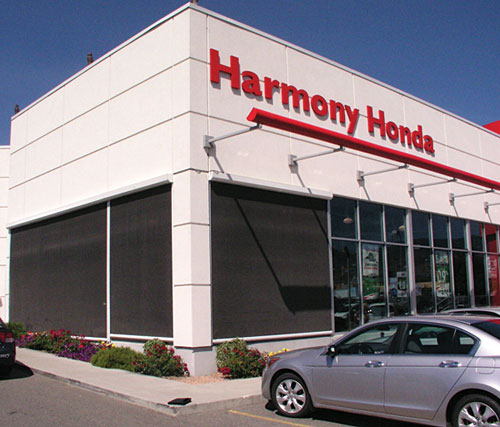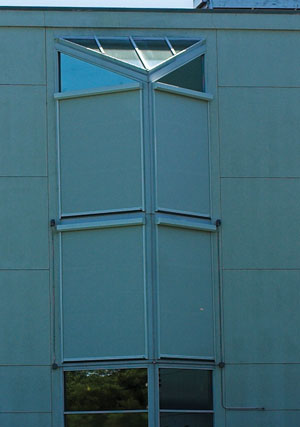Comfort on Demand
Retractable Screens
Fixed shading systems like overhangs perform well on south-facing windows, though they will not effectively block direct east or west sunlight that can cause large amounts of heat gain and glare particularly at the beginning and end of the work day. Dynamic systems such as retractable screens perform well on south-facing as well as on east- and west-facing windows. Reacting to changes in the sun's position, dynamic systems optimize the flow of heat and light energy through the façade which, in turn, can contribute to reducing heat load and glare, and boosting natural daylight.
Screens may continue to have value during the winter months when they can protect carpets, drapes and furniture, and reduce wind chill on the window surface. According to the Web site of manufacturer Phifer Incorporated, the screens can provide as much as a 15 percent increase in the thermal performance of the window during colder months. This helps to reduce heat loss in the building interior. Early tests were conducted in general accordance with ASTM C236-66 in which a 15-mile-per-hour (24-kilometer-per-hour) dynamic wind was applied perpendicular to a plane of 1/4-inch thick clear glass at the exterior; natural convection conditions were applied to the interior of the glass. Results showed that a 0.00 psf pressure differential was maintained across the specimen to insure measurement of conductive thermal transmittance only. Under these conditions the thermal transmittance, or U value, showed a 15 percent improvement, indicating that the tight weave of the screen was effective in reducing the wind chill factor on the glass surface to maintain warmer, more constant glass temperatures.
 |
Retractable screens help shade the showroom of a Honda dealership. Photo courtesy of Phantom Screens |
Â
With automated systems, screens can be automatically lowered during winter nights to provide added insulation, or raised during summer nights to help cooling. In addition, allowing sun into the building when screens are retracted during the colder months can help harness the sun's radiant power when applicable.
 |
Automated retractable screens with sun and wind sensors deploy retractable screens to minimize solar heat gain at the Gordon Head Recreation Center. Photo courtesy of Phantom Screens |
According to architect d'Andre Willis, AIA, LEED AP, of HGA Architects in Milwaukee, the aim of a good daylighting strategy is to use natural light during the day so as to dim or entirely turn off banks of electric lights, while guarding against excessive heat gain and glare. "It's great to have a connection to the outdoors," Willis says. "But if it's not controlled, it can be tough on the people inside. It's important not to ‘over' light a space."
That was the situation faced by a Honda dealership in British Columbia. With 20-foot-high (6-meter-high) ceilings in a glass front south-facing showroom, glare and heat became considerable problems. To shade the interior and reduce glare and heat gain, externally-mounted, oversized motorized retractable screens were installed. Black mesh was used with an openness factor of 10 percent, and UV blockage of 90 percent. "The screens have made a huge difference in heat stoppage and glare reduction," says Owner and General Manager, Manse Binkley. Binkley notes that the screens have been operating at the dealership for more than seven years without requiring mesh replacement or other repair. "The mesh is very durable, and there is no problem when it snows," he says. "We lubricate the channel about once a year to keep the screens operating smoothly. The screens have made a difference in the dealership."
The District of Saanich in Victoria, British Columbia, also faced a heat gain issue at the Gordon Head Recreation Center. The center's west-facing wall of windows allowed excess sun into the pool area on sunny afternoons resulting in an uncomfortable heat buildup inside. Retractable oversized power screens with 90 percent sun and UV blockage and a 10 percent openness factor were installed on six of the eight west windows. A completely automated system with a sun and wind sensor was also installed to monitor the amount of sunlight and deploy the screens prior to the sun hitting the west side walls and allowing the solar heat gain to occur. The sensor also retracts the screens during periods of excessive winds, a condition that the staff was having difficulty monitoring. "There is a noticeable difference in the temperature on the deck and an even bigger difference when the sun and wind sensors were installed," says John McKain, Building Service Worker ll Supervisor at the Gordon Head Recreation Center.









